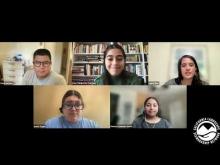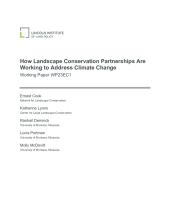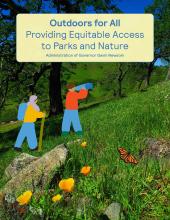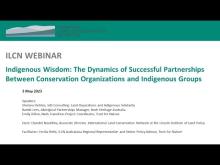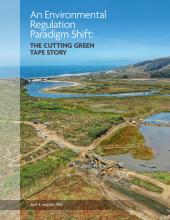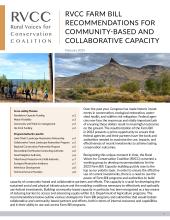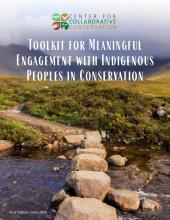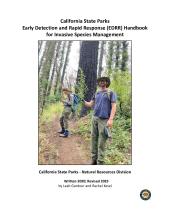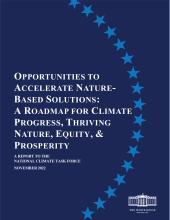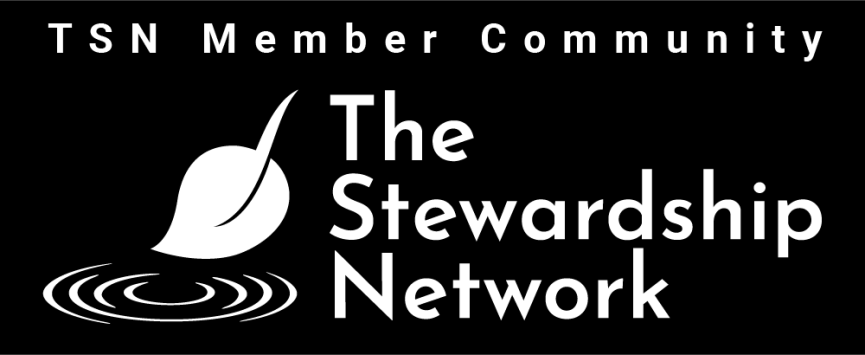- Details
On August 10, 2023, we were joined by four rising leaders in California to continue highlighting efforts statewide that center equity, justice, Tribal sovereignty, and inclusion in the stewardship of land, water, and communities:
- Barbara Camacho Garcia, Grassroots Ecology
- Benjamin Chang, California Climate Action Corps
- Ivette Torres, The People's Collective for Environmental Justice
- Irene Takako Farr, Better World Group
This series is hosted by the CLSN’s Justice, Equity, Diversity, & Inclusion Roundtable for Healing Severed Connections. This lunchtime conversation was moderated by JEDI Roundtable member Laurel Wee.
- Details
-
The Lincoln Institute of Land Policy, in partnership with the Network for Landscape Conservation and the University of Montana, has released a working paper exploring the role of large landscape conservation in providing nature-based climate solutions.
Land conservation addresses climate change both by mitigating greenhouse gas emissions and by helping human and natural communities adapt to the changes caused by global warming. To be most effective, land conservation strategies dealing with climate change need to be implemented at scale and typically require collaboration among many partners who need to work together to overcome obstacles like political boundaries, uncoordinated plans, competition for funding and cultural conflicts.
This paper examines the experience of collaborative partnerships in dealing with climate change. The examination draws from a recent online survey of landscape conservation partnerships, interviews with over 40 practitioners, web research, and email communications. This paper presents practices that appear to be most effective and makes recommendations that can accelerate and broaden the benefits of landscape conservation and restoration in meeting climate goals.
- Details
-
The Outdoors for All strategy charts progress on equitable outdoor access to date, highlights work underway, and identifies additional actions to realize the promise of a California for All. This strategy outlines pathways that government, community organizations, philanthropy, private sector, and residents across California can take together to continue increasing access to the outdoors and nature.
- Details
-
Indigenous cultures have stewarded nature for thousands of years but today's conservation approaches often sideline this knowledge – to the detriment of stewardship efforts, Indigenous peoples and the planet. In the first of a 2-part webinar series, we hear from speakers from the U.S. and Australia about the dynamics of successful partnerships between conservation organizations and Indigenous groups, both in the management of conservation lands and in Indigenous handbacks of conservation lands. The key focus is on the ‘how’: How to partner with and support Indigenous-led conservation, including best practices, strategies for reciprocity, and turning listening into action.
- Details
-
A paradigm shift is inherently complex and difficult to achieve. It is particularly challenging within a layered, multiagency regulatory environment that has been built over decades. However, it can be done. This case study examines one promising example—Cutting Green Tape (CGT)—that not only aims to increase regulatory and permitting efficiencies, but also to shift our collective thinking about how multibenefit environmental restoration projects in California can happen.
The CGT case study allows us to explore the evolution and current status of a perceived paradigm shift. This case study’s researchoriented lens and consideration of Kuhn’s seminal work on shifting paradigms (1970) reveals CGT’s progression in a way that can be applied by a wide range of professional audiences. Insights are shared with those seeking to create such a shift within regulatory (or similar) contexts.
Findings indicate that a paradigm shift for environmental restoration work in California is indeed underway. CGT is moving into the final phase of a five-phase process (see Five Phases of a Paradigm Shift). Two of the four signs of a true paradigm shift (see Four Signs of a Paradigm Shift) have been fulfilled, and there are initial indicators of progress towards the third sign of change as well. However, while promising, CGT as a new paradigm (i.e., a profound change in approach or underlying assumptions) has yet to be fully realized.
- Details
-
The reauthorization of the Farm Bill in 2023 presents a prime opportunity to ensure that federal agencies and their partners have the tools and authorities needed to maximize the use, impacts, and effectiveness of recent investments to achieve lasting conservation outcomes.
Recognizing this unique moment in time, the Rural Voices for Conservation Coalition (RVCC) convened a working group to develop recommendations for the 2023 Farm Bill. Capacity-building quickly rose to the top as our priority topic. In order to ensure the effective use of current investments, there is a need to use the power of Farm Bill programs and authorities to build capacity of community-based and collaborative partners and efforts. This capacity is crucial for developing the sustained social and physical infrastructure and the enabling conditions necessary to effectively and optimally use federal investments. Building community-based capacity in particular has been recognized as a key means of reducing barriers to access and advancing equity within U.S. Department of Agriculture programs. The recommendations below outline various strategies for Farm Bill programs and authorities that would bolster collaborative and community-based partners and efforts, both in terms of internal resources and capabilities and in their ability to use and access Farm Bill programs.
- Details
There is an increasing need for recognizing Indigenous sovereignty when defining successful conservation outcomes. Even when conservation focuses on a “do no harm” approach towards Indigenous Peoples and communities, the contributions, perspectives, and resulting benefits are often not taken into consideration, thereby increasing social and environmental inequities. When those affected by environmental decisions are excluded from the decision-making process, opportunities to collaboratively solve problems in new, innovative, and empowering ways are limited. To help fill this gap, in this Toolkit we seek to build a roadmap where conservation practitioners can support solutions which are driven by community expertise and needs.
- Details
This Early Detection Rapid Response (EDRR) Handbook for Invasive Species Management is designed for California State Parks (Parks) district natural resource managers and those planning and conducting terrestrial early detection surveys, field crews collecting data and eradicating new weeds, and partners, volunteers, or other groups interested in assisting in and following these methods.
California State Parks Natural Resources Division (NRD) embarked on an EDRR pilot project in 2012 with Santa Cruz and Orange Coast Districts volunteering to lead the effort. Their Natural Resources (NR) staff contributed hundreds of hours in development of the methods and tested them firsthand. In 2014, Sierra, North Coast Redwoods, and San Diego Coast Districts joined the training and data collection effort.
The original handbook was written in 2015 by Ramona Robison and Nita Barve (NRD) with Tim Hyland and Daniella Schweizer (Santa Cruz District). Technical assistance and review were provided by the Santa Cruz Resource Conservation District and the California Invasive Plant Council (Cal-IPC). Some of the contents of the original handbook have been preserved; we have updated and expanded on various components for greater clarity and utility. The 2020 version was reviewed by Tim Hyland (Santa Cruz), Lana Nguyen (Orange Coast), and Michelle Forys (North Coast Redwoods) who are all implementing successful EDRR programs in their respective districts. The 2023 revision incorporates minor changes and additions.
- Details
-
On December 6, 2022, we were joined by Chanell Fletcher, Deputy Executive Officer for Environmental Justice at California Air Resources board. Over the course of an hour, Chanell and moderator Barb Kipreos talked expansively about working toward air quality standards and the need to orient toward justice.
- Details
-
This report provides a roadmap with five strategic recommendations for federal agencies to unlock the potential of nature-based solutions and highlights bold Executive Office of the President actions designed to pave the way. Importantly, these recommendations position the United States to prioritize nature-based solutions as go-to options in fighting climate change, nature loss and inequities.
The recommendations in this report are some of the best opportunities we have to meet climate goals and grow climate-ready communities, economies, and sectors. All have a role to play in turning these recommendations into action. President Biden and his National Climate Task Force are in a position to act boldly and lead adoption of these recommendations, advancing naturebased solutions as powerful tools that the nation and the world need now.


